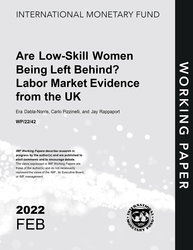
Are Low-Skill Women Being Left Behind? Labor Market Evidence from the UK
Are Low-Skill Women Being Left Behind? Labor Market Evidence from the UK
READ MORE...
Volume/Issue:
Volume 2022
Issue 042
Publication date: February 2022
ISBN: 9798400202384
$5.00
Add to Cart by clicking price of the language and format you'd like to purchase
Available Languages and Formats
| English |
Prices in red indicate formats that are not yet available but are forthcoming.
Topics covered in this book
This title contains information about the following subjects.
Click on a subject if you would like to see other titles with the same subjects.
Labor , Economics- Macroeconomics , Economics / General , Demography , Job polarization , Occupational choice , Life-cycle , Cohorts , Intergenerational inequality , cohort effect , job polarization , wage inequality , JEL classification number , labor market evidence , Wages , Women , Employment , Labor markets , Aging
Summary
Labor markets in the UK have been characterized by markedly widening wage inequality for lowskill (non-college) women, a trend that predates the pandemic. We examine the contribution of job polarization to this trend by estimating age, period, and cohort effects for the likelihood of employment in different occupations and the wages earned therein over 2001-2019. For recent generations of women, cohort effects indicate a higher likelihood of employment in low-paying manual jobs relative to high-paying abstract jobs. However, cohort effects also underpin falling wages for post-1980 cohorts across all occupations. We find that falling returns to labor rather than job polarization has been a key driver of rising inter-age wage inequality among low-skill females. Wage-level cohort effects underpin a nearly 10 percent fall in expected lifetime earnings for low-skill women born in 1990 relative to those born in 1970.
Copyright © 2010 - 2025
Powered by:
AIDC



